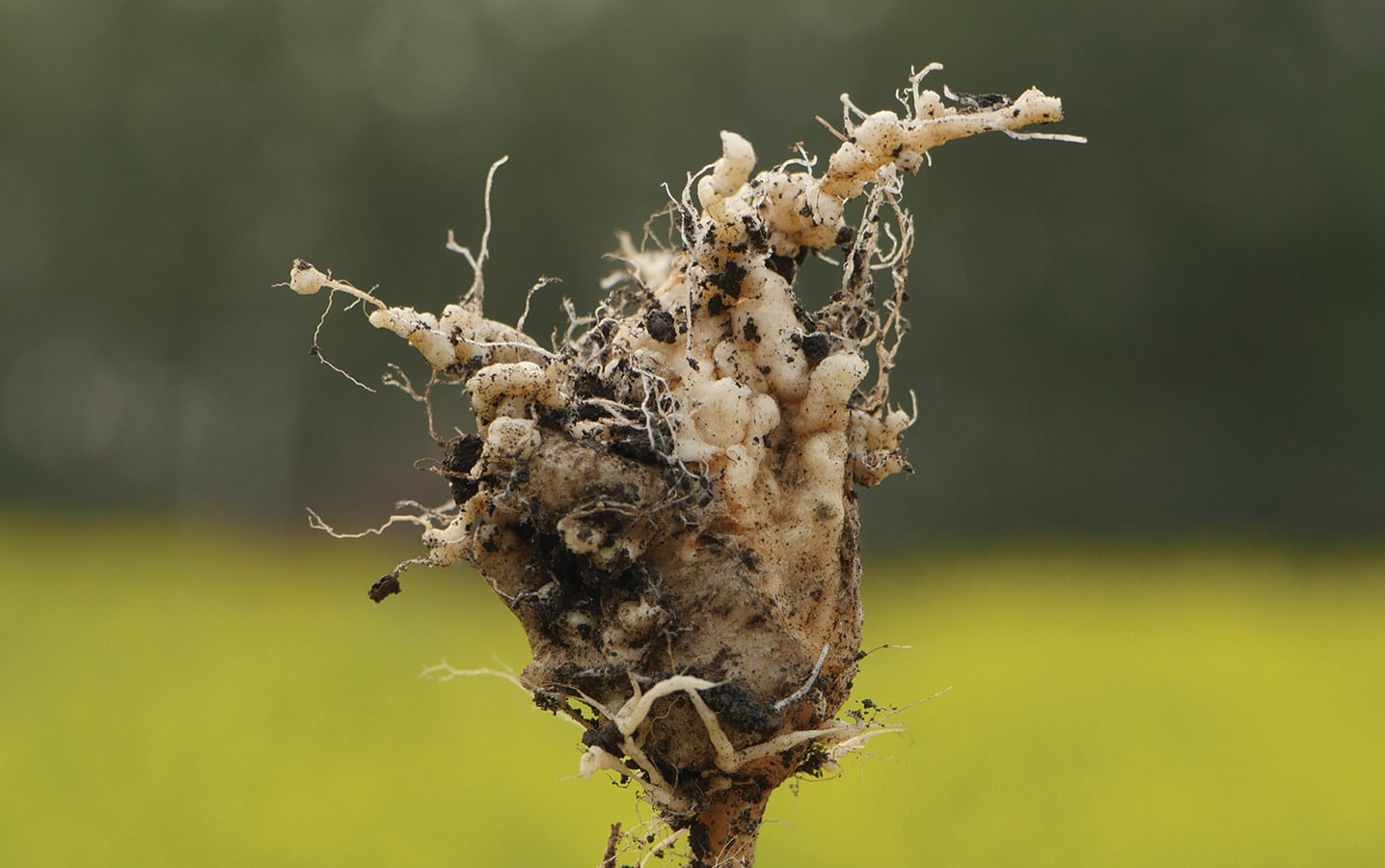Clubroot around the world
The clubroot pathogen Plasmodiophora brassicae was first detected in Europe in the 1870s, but was probably there for centuries. Clubroot disease was documented in the U.S. in 1853 and found in China and Japan about 100 years ago. The disease is now found in all brassica-growing areas of the world, and seems to be getting worse everywhere — partly due to tighter rotations and partly due to favourable (moist) conditions for higher yield and high disease. The International Clubroot Workshop included updates from various countries.
Canada
Canada had its first documented cases in the early 1900s in brassica vegetable crops in Eastern Canada. European settlers probably carried clubroot to North America on the fodder turnips they brought with them. On the Prairies, there were occasional reports of clubroot in home and market gardens over the decades, but the disease was not identified on canola until its discovery in 12 Alberta fields in 2003. Here are 2018 updates for the three Prairie provinces:
- Alberta. Cumulative counts in Alberta reached 3,035 fields as of 2018. New counties confirmed to have clubroot are Rocky View around Calgary and Greenview, Northern Sunrise and Birch Hills in the Peace region.
- Saskatchewan. An extensive field survey in 2018 brought the total number of fields with confirmed visible symptoms of clubroot to 37. The area where clubroot has been confirmed has expanded outside of crop districts 9AE, 9AW and 9B (2017 findings) to include crop districts 7B, 6B, and 5B. All growers will be contacted and advised to follow the protocols outlined in the Saskatchewan Clubroot Management Plan. Find a link to the plan in the ‘Regulations’ section at clubroot.ca.
- Manitoba. Fifteen new fields were confirmed to have clubroot symptoms in 2018, bringing the total number of confirmed fields up to 33 across seven rural municipalities. Dane Froese, Manitoba Agriculture’s oilseeds specialist, says all newly identified fields were in the rural municipalities of Pembina, Louise, Lorne and Dufferin. “The latter two are newly identified ‘hot’ municipalities for clubroot,” he says.
- University of Alberta researcher Stephen Strelkov says the spread of clubroot in Western Canada has been rapid for a soil-borne disease. For updates, go to clubroot.ca and click on the ‘Affected regions’ box.
“The spread of clubroot in Western Canada has been rapid for a soil-borne disease.”
United States
Venkat Chapara is a plant pathologist with North Dakota State University. North Dakota is the top canola-producing state in the U.S., with about 1.6 million acres in each of the past two years. In 2016, Chapara surveyed 48 fields in the state’s Cavalier County and found clubroot in one field. In 2017, 10 per cent of fields in the county had clubroot. In 2018, 33 of 101 fields surveyed had clubroot and the worst samples had 13 million spores per gram of soil. Cavalier is by far the worst county for clubroot in the U.S., and the disease has become very common, especially in low pH (ranging from 4.5-6.4) soils, Chapara says. For point of reference, Cavalier County is on the Manitoba border, stretching from south of Crystal City in the west to south of Winkler in the east.
United Kingdom
“We have a huge problem with clubroot in the U.K.,” says Fiona Burnett, plant pathologist with Scotland’s Rural College. Oilseed rape (OSR) is the second most profitable crop in the U.K., after wheat, she says, but more than half of arable fields in the country are infested with clubroot and pathotypes that break the common “Mendel” source of genetic resistance are everywhere.
Germany
“Unfortunately we have a big problem with clubroot nowadays.”
The biggest OSR-producing country in Europe has had clubroot for at least 100 years. Frequency of OSR in the rotation correlates with the incidence and prevalence of clubroot disease and has helped select for pathotypes that are virulent to Mendel, the main source of resistance in most varieties. “Unfortunately we have a big problem with clubroot nowadays,” says Nazanin Zamani-Noor, researcher at the Julius Kuehn-Institute in Braunschweig, Germany.
Poland
Poland is the third biggest OSR-producing country in Europe after Germany and France. A survey by Malgorzata Jedryczka at the Polish Academy of Sciences found that one third of fields surveyed in 2017 had clubroot. Key factors for the increase in clubroot, she says, are tight rotations and the moderately to extremely acidic nature of most Polish soils.
France
Clubroot is now “extreme” in France, and 68 per cent of fields have pathotypes that can overtake the resistance in Mendel.
Japan
Japanese farmers grow a lot of brassica crops – cabbage and Chinese cabbage, broccoli and komatsuna – and clubroot is “their most troubling soil pest,” say Japanese researchers who presented at the International Clubroot Workshop. Katsunori Hatakeyama, associate professor at Iwate University in Japan, says most Chinese cabbage varieties grown in Japan have clubroot resistant (CR) traits, but “CR is sometimes broken down.”
South Korea
Clubroot is a significant problem in vegetable brassicas in Korea, says Strelkov from U of A. Korean researchers are active in the genetics of resistance and management of the disease.
China
Up to 10 million acres of cruciferous crops are infected by the clubroot pathogen annually in China, Strelkov says, and the disease is estimated to cause yield losses of 20 to 30 per cent.
Colombia
Go to canoladigest.ca to read Jay Whetter’s article “Global concern, local action” with clubroot management tips from the International Clubroot Workshop.
In a 2017 national survey, 53.6 per cent of fields tested positive for clubroot. Colombia’s brassica crops are cabbage, broccoli and cauliflower, which tend to be very sensitive to clubroot. Andrea Botero-Ramirez, a Colombian and a Ph.D student working with Strelkov at U of A, says these crops have shown a 30-43 per cent yield drop with spore density of only 1,000 spores per gram of soil, and 60-75 per cent yield drop with spore density of 1,000,000 per gram. Part of the problem in Colombia is tight rotations. Fields have cruciferous crops for six months of the year then usually rotate to potatoes, lettuce, corn or carrots for six months.






